In the realm of livestock nutrition, homemade feed formulations offer a tailored approach, optimizing nutrient balance from starter to finisher stages. By blending livestock feed ingredients strategically, farmers can create customized feeds that enhance feed efficiency and overall animal health. From swine feed formulations to mineral supplements, each component plays a vital role.
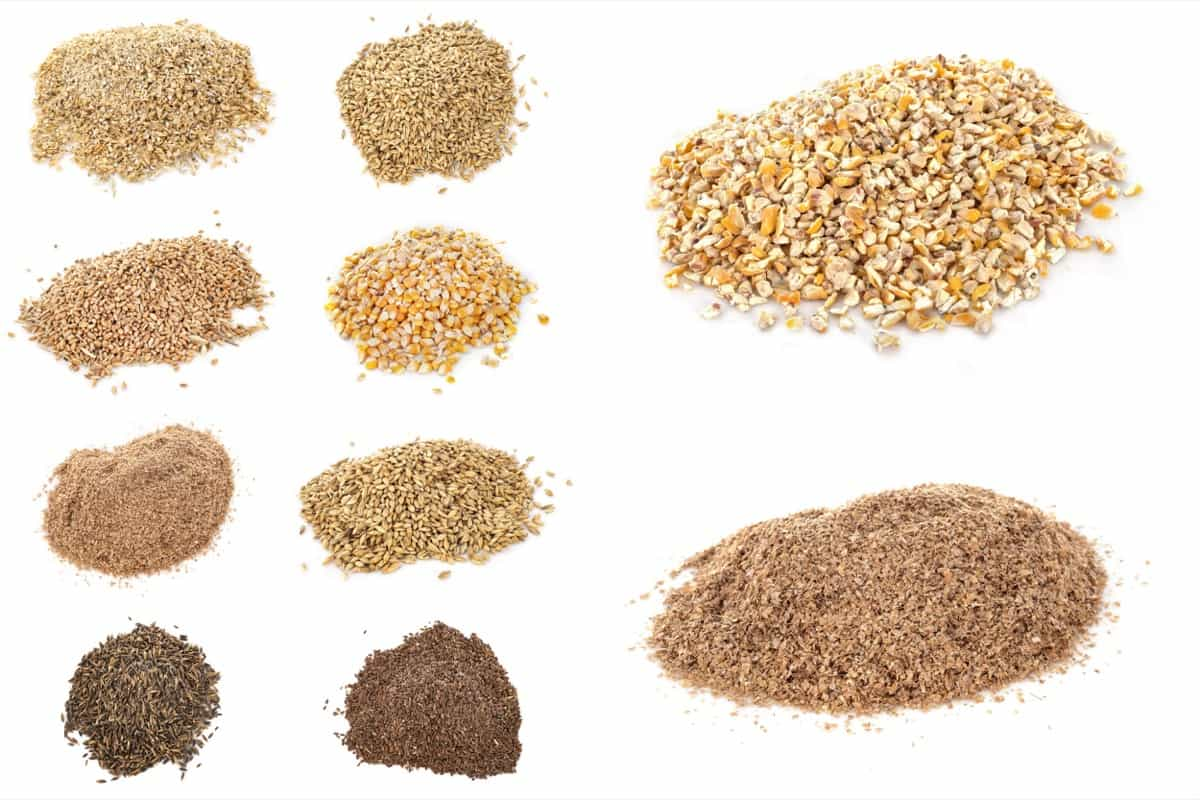
Natural additives bolster feed quality, promoting optimal growth and development. Moreover, prioritizing cost-effective animal feed solutions ensures sustainability without compromising on nutrition. With proper mixing techniques and attention to detail, homemade livestock feed emerges as a cornerstone in modern farming practices, catering to both economic and nutritional demands.
Livestock Nutritional Needs
Livestock needs different nutrients to perform various functions such as growth, reproduction, lactation, and maintenance. The main nutrients required by livestock are water, energy, protein, minerals, and vitamins. The amount and proportion of each nutrient depends on the type, age, weight, and production level of the animal. For example, growing animals need more protein than mature ones, and lactating animals need more energy and minerals than non-lactating ones. Nutrient requirements can be expressed as daily or per unit of body weight or product (e.g., milk, meat, eggs).
Factors Affecting Livestock Nutrition
Livestock nutritional needs and intake are influenced by various factors, including environmental factors like temperature, humidity, altitude, and season; health issues like diseases, parasites, and stress; and feed quality and availability. Environmental factors like temperature, humidity, altitude, and season can affect energy expenditure and water consumption, while health issues like diarrhea and worms can reduce nutrient absorption and utilization.
Feed quality and availability also play a role, with fresh grass having more water and less energy than hay and grains having more energy and less fiber than roughage. The availability of feed also affects animal performance, with animals consuming less when it is scarce, spoiled, or unpalatable.
Key Ingredients for Homemade Livestock Feed
Energy sources: These are feeds that provide carbohydrates and fats to supply the energy for various body functions and activities. Examples of energy sources are:
- Grains (e.g., corn, wheat, barley).
- By-products (e.g., molasses, distiller’s grains).
- Oilseeds (e.g., soybean, sunflower).
- Oil cakes (e.g., soybean meal, cottonseed meal).
Protein sources: These are feeds that provide amino acids to build and repair body tissues and produce milk, meat, and eggs. Examples of protein sources are:
- Legumes (e.g., peas, beans).
- Oil cakes (e.g., soybean meal, cottonseed meal).
- Animal products (e.g., fish meal, blood meal).
- By-products (e.g., corn gluten meal, brewer’s grains).
In case you missed it: Livestock Vaccination Cost in India: Exploring Strategies to Reduce Animal Vaccination Costs
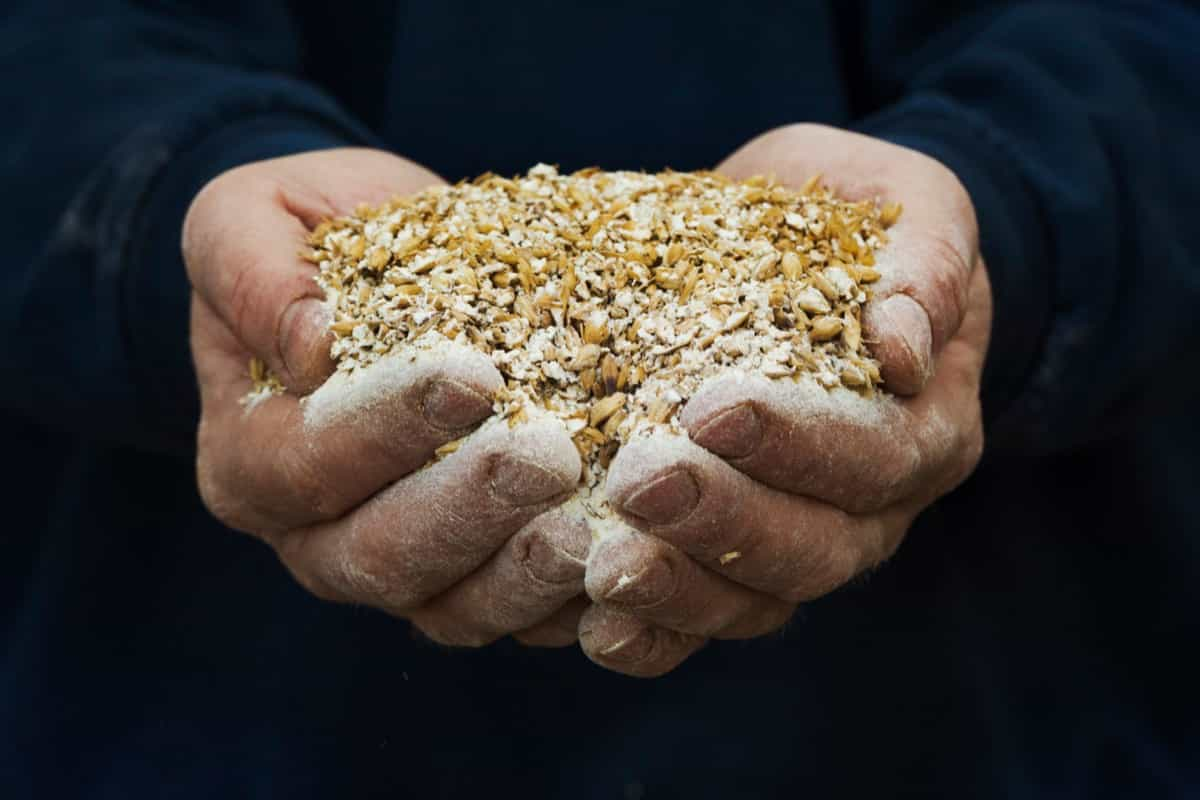
Mineral sources: These are feeds that provide macro-minerals (e.g., calcium, phosphorus, magnesium) and micro-minerals (e.g., iron, zinc, copper) to support bone formation, enzyme activity, and immune function. Examples of mineral sources are limestone, dicalcium phosphate, salt, and mineral premixes.
Vitamin sources: These are feeds that provide fat-soluble vitamins (e.g., A, D, E, K) and water-soluble vitamins (e.g., B complex, C) to regulate metabolism, vision, reproduction, and health. Examples of vitamin sources are:
- Green forages (e.g., alfalfa).
- Oilseeds (e.g., sunflower).
- Animal products (e.g., liver).
- Vitamin premixes.
Formulating Starter Feed for Young Livestock
Starter feed is the first solid food for young livestock after weaning, designed to provide adequate nutrition for growth and development, stimulate rumen function, and stimulate growth in ruminant animals. Common components include corn, oats, barley, wheat, soybean meal, alfalfa hay, molasses, salt, and premixes. Balancing nutrition for growing animals is crucial, as their nutritional requirements vary based on species, breed, age, weight, and health status.
Protein for muscle growth, tissue repair, and immune function, and starter feed should have a protein level between 16% and 22%, depending on the animal type. Energy is needed for maintenance, growth, and activity, and starter feed should have an energy level between 70% and 80% of total digestible nutrients (TDN), mainly from starch and sugar.
Minerals are crucial for bone development, enzyme function, and metabolic processes, and starter feed should meet the daily requirements of each animal type. Vitamins are involved in biochemical reactions and physiological functions, and starter feed should have a sufficient vitamin level to prevent deficiencies and support health.
Grower Feed Formulation for Developing Livestock
Grower feed is the second stage of solid food for developing livestock, providing optimal nutrition for growth and development. It typically contains moderate levels of protein, energy, minerals, vitamins, and fibrous ingredients to promote rumen function and health. Common ingredients include corn, oats, barley, wheat, soybean meal, cottonseed meal, alfalfa hay, beet pulp, molasses, salt, and premixes.
As developing livestock grow older and heavier, the nutritional needs of each animal group change. To meet these needs, grower feed should be adjusted to specific needs of each animal group. Protein for muscle growth, tissue repair, and immune function, and the protein level should be between 12% and 18%, depending on the animal type. Energy is also essential for maintenance, growth, and activity, with an energy level between 60% and 70% of TDN.
Homemade Feed Formulations for Livestock
Finisher Feed Recipes for Mature Livestock
Crafting finisher feed recipes for mature livestock requires a blend of nutrients tailored to their specific needs. A balance of protein, carbohydrates, and fats promotes optimal growth and muscle development, preparing animals for the market while ensuring their overall health and well-being.
In case you missed it: Berseem Forage Cultivation: Best Fodder Farming for Livestock
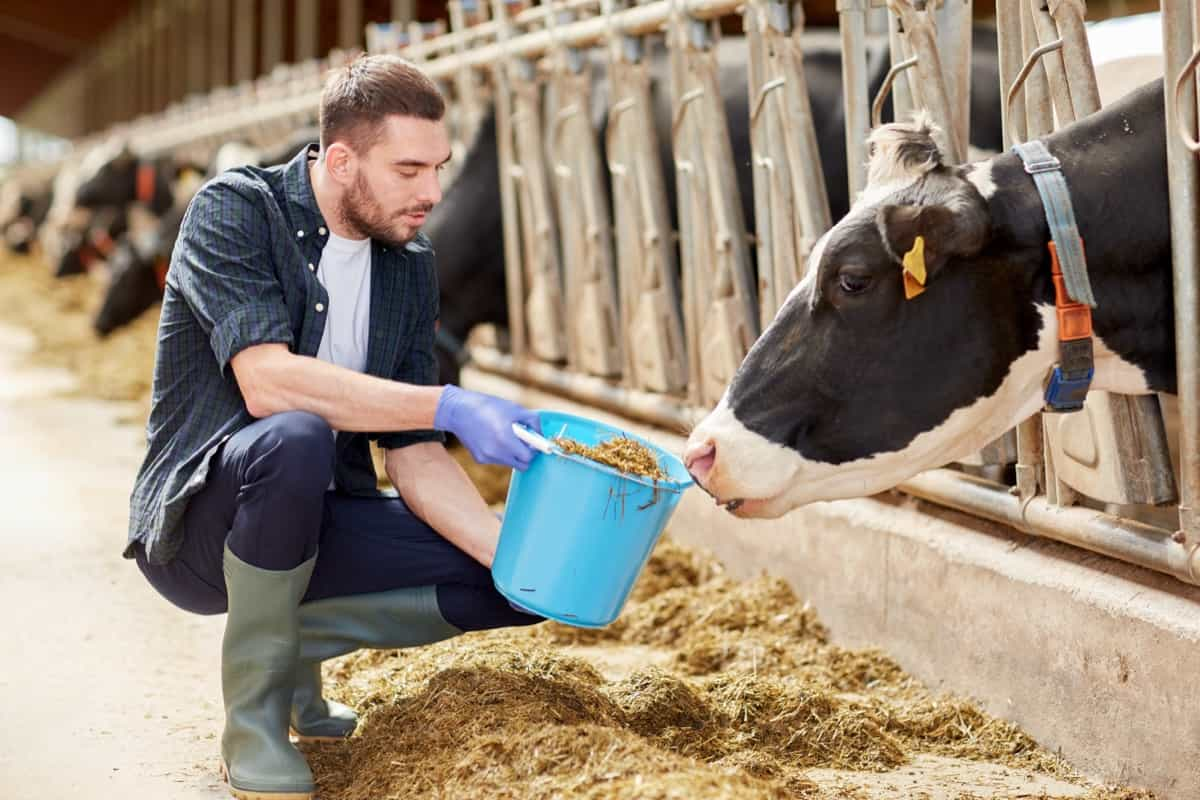
Composition of Finisher Feed
Finisher feed typically consists of grains such as corn, barley, and wheat, supplemented with protein sources like soybean meal or fishmeal. Fat sources like vegetable oils may be added for energy, along with vitamins and minerals, to meet nutritional requirements. Balancing these ingredients is crucial for optimal performance.
Preparing Livestock for Market
Proper nutrition is essential in preparing livestock for the market. Finisher feed formulations ensure animals reach their desired weight and condition, maximizing profit for farmers. A gradual transition to finisher feed helps prevent digestive upset and ensures a smooth transition to the finishing phase before sale or butchering.
Customized Feed Formulas for Livestock
Customized feed formulas allow farmers to tailor nutrition to the specific needs of their animals. Factors such as breed, age, and intended use are considered when formulating feeds, ensuring each animal receives the nutrients for optimal growth, health, and performance.
Tailoring Feed for Specific Animal Needs
Different animals have varying nutritional requirements based on factors such as species, age, and physiological status. Tailoring feed formulations to meet needs ensures optimal health, growth, and productivity, ultimately leading to better overall performance and profitability for farmers.
Adjusting Formulas for Different Growth Stages
As animals grow and develop, their nutritional needs change. Adjusting feed formulas to accommodate these different growth stages is essential for promoting optimal health and development. Starter feeds provide essential nutrients for young animals, while finisher feeds support muscle growth and weight gain as animals mature.
Nutrient Balance in Homemade Livestock Feed
Achieving the right balance of nutrients in homemade livestock feed is crucial for supporting optimal growth and performance. Balancing protein levels ensures muscle development while managing energy content provides animals with the energy they need for daily activities and growth.
Achieving the Right Protein Levels
Protein for muscle development and overall growth in livestock. Ensuring the right protein levels in homemade feed formulations supports muscle growth, reproduction, and overall health. Protein sources such as soybean meal, fishmeal, and legumes are commonly used to meet these requirements.
Managing Energy Content
Managing the energy content of homemade feed is critical for meeting the energy needs of livestock. Carbohydrates and fats are primary energy sources in feed formulations, providing animals with the energy they need for growth, maintenance, and production activities.
In case you missed it: Moringa as Feed for Livestock: Moringa Fodder Crop Yield Per Acre
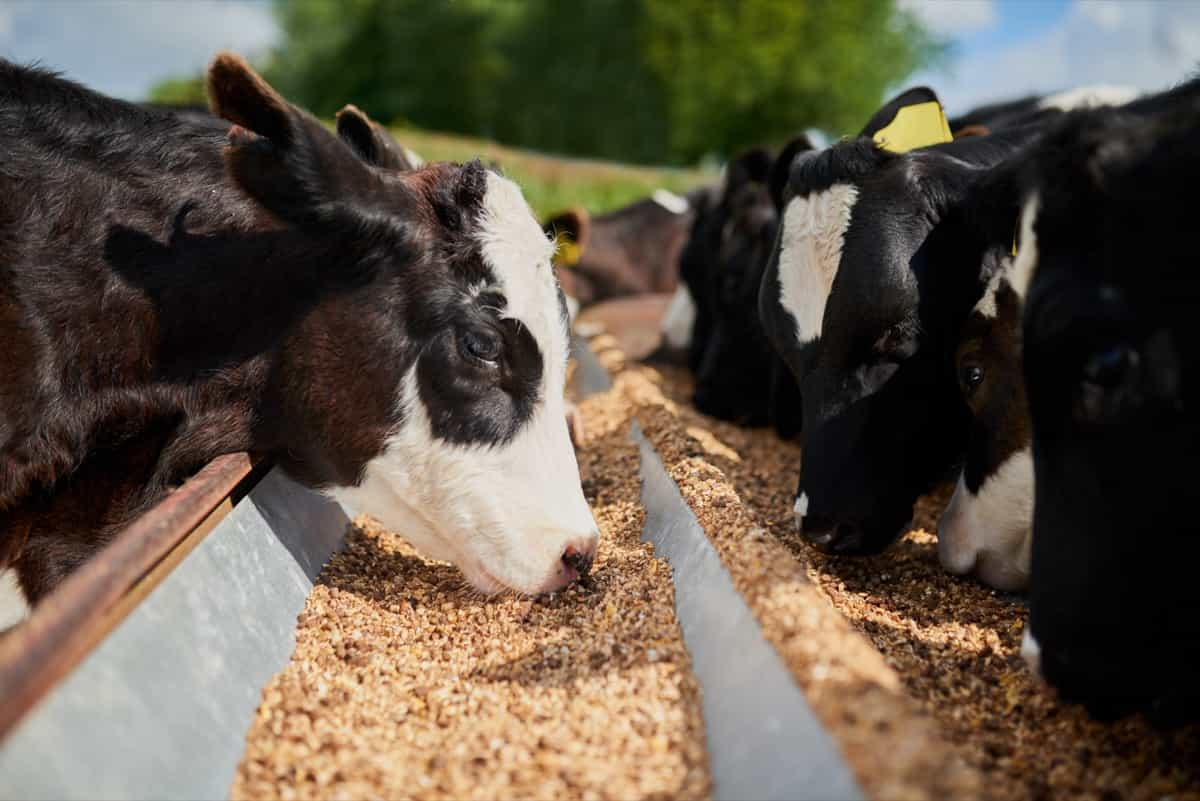
Mixing and Preparing Homemade Livestock Feed
Proper mixing techniques are essential for ensuring uniform distribution of nutrients in homemade livestock feed. Thoroughly mixing ingredients helps prevent nutrient imbalances and ensures animals receive consistent nutrition with each feeding.
Ensuring Feed Hygiene and Safety
Maintaining feed hygiene and safety is crucial for preventing contamination and ensuring the health and safety of livestock. Proper storage, handling, and processing practices help minimize the risk of foodborne and maintain the quality of homemade feed.
Testing and Quality Assurance for Livestock Feed
Regular testing, quality assurance measures are essential for ensuring the nutritional quality and safety of homemade feed. Nutrient analysis helps verify nutrient levels, while quality control measures help identify, address any potential issues with feed quality and safety.
Nutrient Analysis of Homemade Feed
Nutrient analysis involves testing homemade feed samples to determine their nutrient content. This information helps farmers assess the nutritional adequacy of their feed formulations and make any necessary adjustments to meet the needs of their animals.
Quality Control Measures
Implementing quality control measures helps maintain the quality and safety of homemade feed. This may include regular inspections, monitoring for contaminants, and following proper processing and storage procedures to ensure feed integrity.
Cost-Effective Homemade Feed Solutions
Developing cost-effective homemade feed solutions involves sourcing affordable ingredients while maintaining nutritional quality. By carefully selecting ingredients and optimizing formulations, farmers can reduce feed costs without sacrificing the health or performance of their animals.
Budget-Friendly Feed Ingredients
Choosing budget-friendly feed ingredients helps minimize feed costs while still meeting the nutritional needs of livestock. Common inexpensive ingredients include grains, legumes, and by-products from food processing industries.
Calculating Feed Costs and Savings
Calculating feed costs involves considering the cost of ingredients, processing, and labor involved in feed production. By comparing these costs to the potential savings from homemade feed production, farmers can assess the economic viability of producing feed on-farm.
Livestock Feed Efficiency
Optimizing feed efficiency is essential for maximizing productivity and profitability in livestock operations. Feed conversion ratios measure the amount of feed required to produce a unit of output, like weight gain or milk production, allowing farmers to identify opportunities for improvement.
Optimizing Feed Conversion Ratios
Improving feed conversion ratios involves optimizing feed formulations and management practices to minimize feed wastage and maximize nutrient utilization by livestock. This helps improve the efficiency and profitability of livestock operations.
In case you missed it: A Guide to Understand Livestock Feeding: Check How this Guide Helps Livestock Farmers
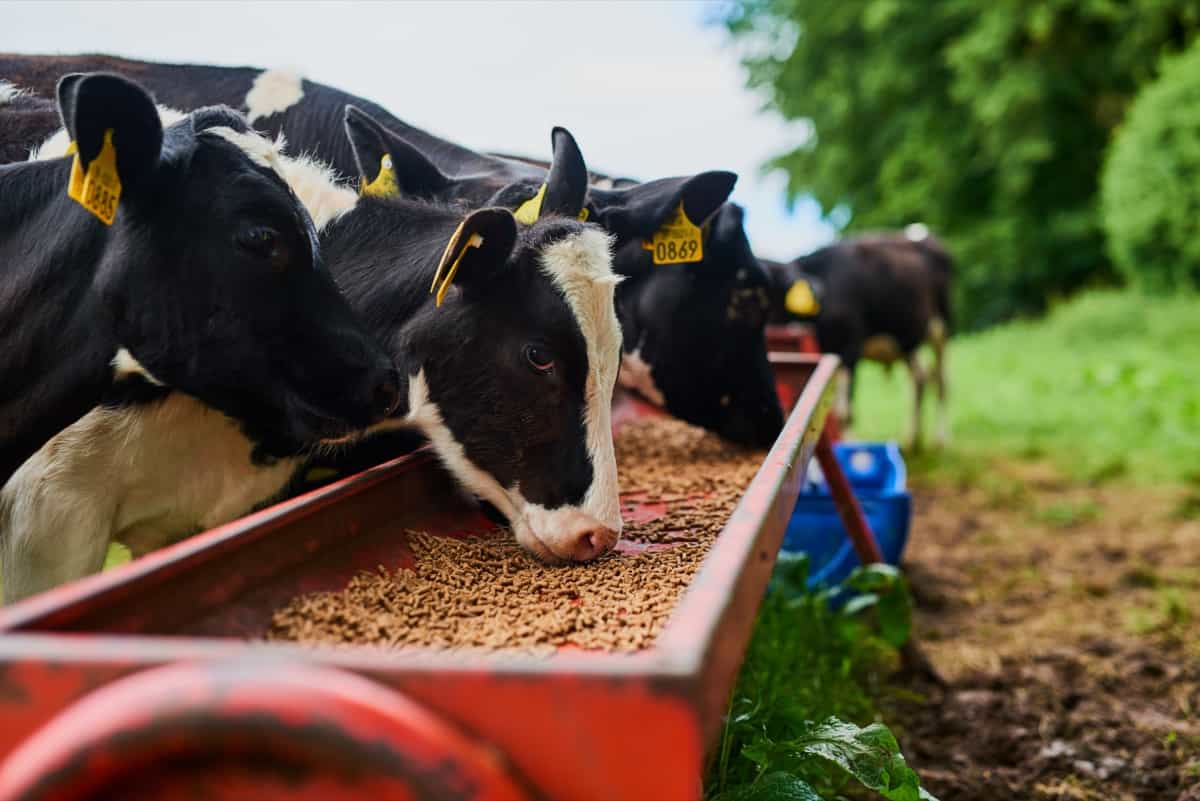
Reducing Feed Wastage
Minimizing feed wastage is crucial for reducing feed costs and improving feed efficiency. Proper feeding management practices, such as using feeders and troughs designed to minimize spillage, help ensure that animals consume the feed provided without waste.
Supplementing Homemade Feed with Minerals
Minerals supporting various physiological functions in livestock. Supplementing homemade feed with essential minerals helps ensure animals receive nutrients for optimal health, growth, and reproduction.
Essential Minerals for Livestock
Essential minerals required by livestock include calcium, phosphorus, magnesium, potassium, and trace minerals such as copper, zinc, and selenium. These minerals are critical for bone development, muscle function, reproduction, and overall health in animals.
Mineral Supplements in Feed
Mineral supplements can be added to homemade feed formulations to ensure animals receive adequate levels of essential minerals. These supplements may be in the form of mineral premixes or individual mineral sources added to feed as needed to meet specific nutritional requirements.
Natural Additives in Homemade Livestock Feed
Incorporating natural additives into homemade livestock feed can enhance nutrient utilization and promote animal health and performance. Herbs, botanical extracts, and other natural ingredients may offer additional benefits such as improved digestion, immunity, and overall well-being.
Incorporating Herbs and Supplements
Herbs and supplements can be added to homemade feed formulations to provide additional health benefits for livestock. Common herbs used in feed include garlic, oregano, and thyme, which have antimicrobial and immune-boosting properties.
Enhancing Feed with Natural Ingredients
Natural ingredients like probiotics, prebiotics, and enzymes can enhance the nutritional quality and digestibility of homemade feed. These ingredients promote gut health, improve nutrient absorption, and support overall animal performance.
Homemade Feed for Poultry
Formulating homemade feed for poultry involves blending grains, protein sources, supplements to meet the specific nutritional needs of chickens, ducks, and turkeys. Customized feed formulations support optimal growth, egg production, and overall health in poultry.
Formulations for Chickens
Chickens require balanced diets rich in protein, energy, vitamins, and minerals for optimal growth and egg production. Homemade feed formulations for chickens typically include grains, soybean meal, calcium sources, and vitamin and mineral supplements to meet these requirements.
In case you missed it: Profitable Pig Breeds: Selecting and Breeding for Success
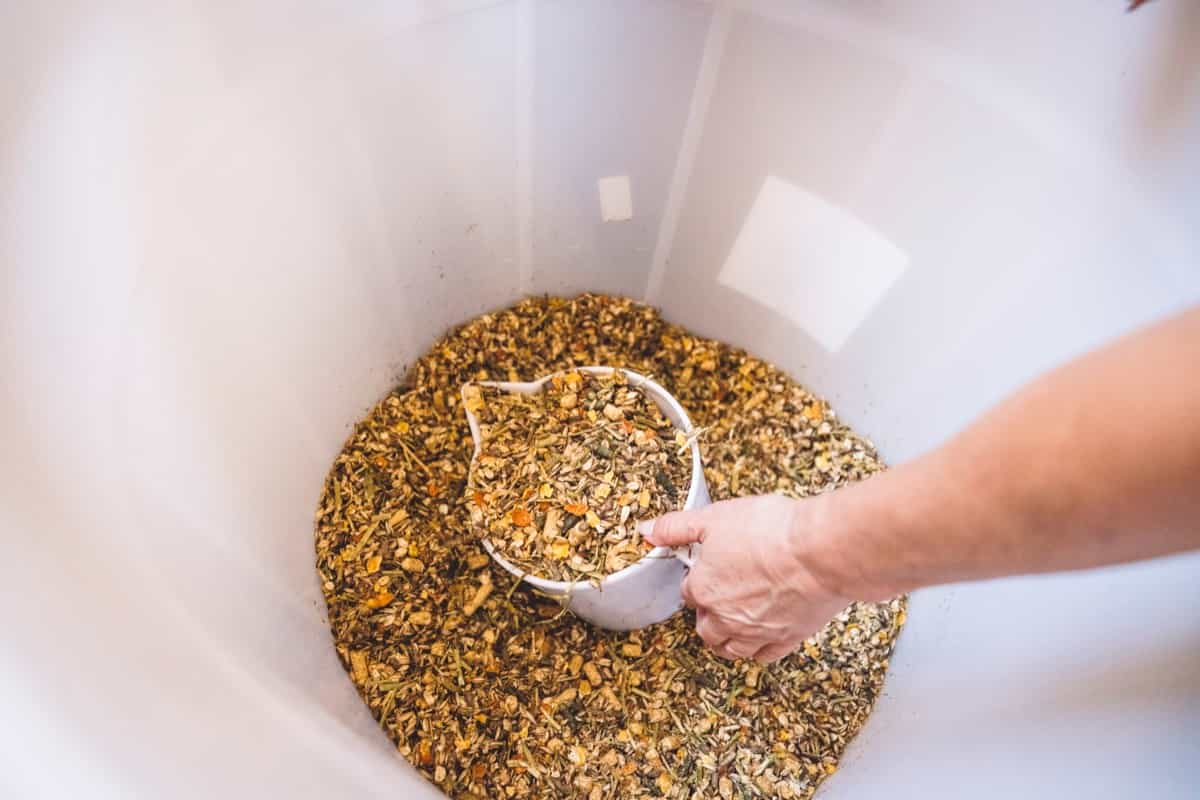
Feed for Ducks and Turkeys
Ducks and turkeys have slightly different nutritional needs compared to chickens, requiring higher levels of certain nutrients such as protein and niacin. Homemade feed formulations for ducks and turkeys may include a higher percentage of protein sources and supplemental niacin to support their unique requirements.
Homemade Feed for Cattle and Dairy Livestock
Customized feed blends for cattle and dairy livestock support optimal growth, milk production, and overall health. These formulations typically include a balance of energy, protein, fiber, vitamins, and minerals to meet the specific nutritional needs of each animal.
Custom Blends for Cows
Cows require diets rich in fiber, energy, and protein to support rumen function, milk production, and body condition. Custom blends for cows may include forages such as hay and silage, along with grains, protein supplements, and mineral premixes to meet their nutritional requirements.
Dairy-Specific Feed Formulations
Dairy cows have unique nutritional needs to support high milk production and reproductive performance. Dairy-specific feed formulations may include high-quality forages, energy-dense grains, protein supplements, and mineral premixes to optimize milk production and cow health.
Homemade Feed for Swine and Pork Production
Swine feed recipes for homemade feed formulations support optimal growth, reproduction, and pork production. Customized blends of grains, protein sources, and supplements provide pigs with the nutrients they need for efficient growth and development.
Swine Feed Recipes
Swine feed recipes typically include a combination of grains such as corn, barley, and wheat, along with protein sources like soybean meal or distillers’ grains. Fat sources such as vegetable oils may be added for energy, along with vitamins and minerals, to meet nutritional requirements.
Preparing Pigs for Butchering
Proper nutrition is essential in preparing pigs for butchering, ensuring optimal growth and carcass quality. Finisher feeds are typically fed during the final weeks before butchering to maximize weight gain and lean muscle development, producing high-quality pork for the market.
Conclusion
Homemade feed formulations provide a cost-effective solution for meeting the nutritional needs of livestock from starter to finisher stages. By customizing recipes and optimizing ingredients, farmers can promote animal health, growth, and profitability sustainably.
- Types of Pesticides Used in Agriculture: A Beginner’s Guide
- Economical Aquaculture: A Guide to Low-Budget Fish Farming
- 15 Common Planting Errors That Can Doom Your Fruit Trees
- How to Make Houseplants Bushy: Effective Tips and Ideas
- Innovative Strategies for Boosting Coconut Pollination and Yield
- Pollination Strategies for Maximum Pumpkin Yield
- The Complete Guide to Chicken Fattening: Strategies for Maximum Growth
- Natural Solutions for Tulip Problems: 100% Effective Remedies for Leaf and Bulb-Related Issues
- Revolutionizing Citrus Preservation: Towards a Healthier, Greener Future
- Natural Solutions for Peony Leaf and Flower Problems: 100% Effective Remedies
- Maximizing Profits with Avocado Contract Farming in India: A Comprehensive Guide
- Natural Solutions for Hydrangea Problems: 100% Effective Remedies for Leaf and Flowers
- The Ultimate Guide to Choosing the Perfect Foliage Friend: Bringing Life Indoors
- From Sunlight to Sustainability: 15 Ways to Use Solar Technology in Agriculture
- The Ultimate Guide to Dong Tao Chicken: Exploring from History to Raising
- The Eco-Friendly Makeover: How to Convert Your Unused Swimming Pool into a Fish Pond
- Mastering the Art of Delaware Chicken Farming: Essentials for Healthy Backyard Flocks
- 20 Best Homemade Fertilizers for Money Plant: DIY Recipes and Application Methods
- How to Craft a Comprehensive Free-Range Chicken Farming Business Plan
- Brighten Your Flock: Raising Easter Egger Chickens for Beauty and Bounty
- How to Optimize Your Poultry Egg Farm Business Plan with These Strategies
- Subsidy for Spirulina Cultivation: How Indian Government Schemes Encouraging Spirulina Farmers
- Ultimate Guide to Raising Dominique Chickens: Breeding, Feeding, Egg-Production, and Care
- Mastering the Art of Raising Jersey Giant Chickens: Care, Feeding, and More
- Ultimate Guide to Raising Legbar Chickens: Breeding, Farming Practices, Diet, Egg-Production
- How to Raise Welsummer Chickens: A Comprehensive Guide for Beginners
- How to Protect Indoor Plants in Winter: A Comprehensive Guide
- Ultimate Guide to Grow Bag Gardening: Tips, Tricks, and Planting Ideas for Urban Gardeners
- Guide to Lotus Cultivation: How to Propagate, Plant, Grow, Care, Cost, and Profit
- Agriculture Drone Subsidy Scheme: Government Kisan Subsidy, License, and How to Apply Online
- Ultimate Guide to Raising Araucana Chickens: Breed Profile, Farming Economics, Diet, and Care
- Bringing Hydroponics to Classroom: Importance, Benefits of Learning for School Students
- Ultimate Guide to Raising Polish Chickens: Breed Profile, Farming Economics, Diet, and Care
- Ultimate Guide to Raising Australorp Chickens: Profile, Farming Economics, Egg Production, Diet, and Care
- Silkie Chicken Farming: Raising Practices, Varieties, Egg Production, Diet, and Care
- Sussex Chicken Farming: Raising Practices, Varieties, Egg Production, Diet and Care